oil temperature FORD F750 2007 11.G Owners Manual
[x] Cancel search | Manufacturer: FORD, Model Year: 2007, Model line: F750, Model: FORD F750 2007 11.GPages: 280, PDF Size: 1.93 MB
Page 9 of 280
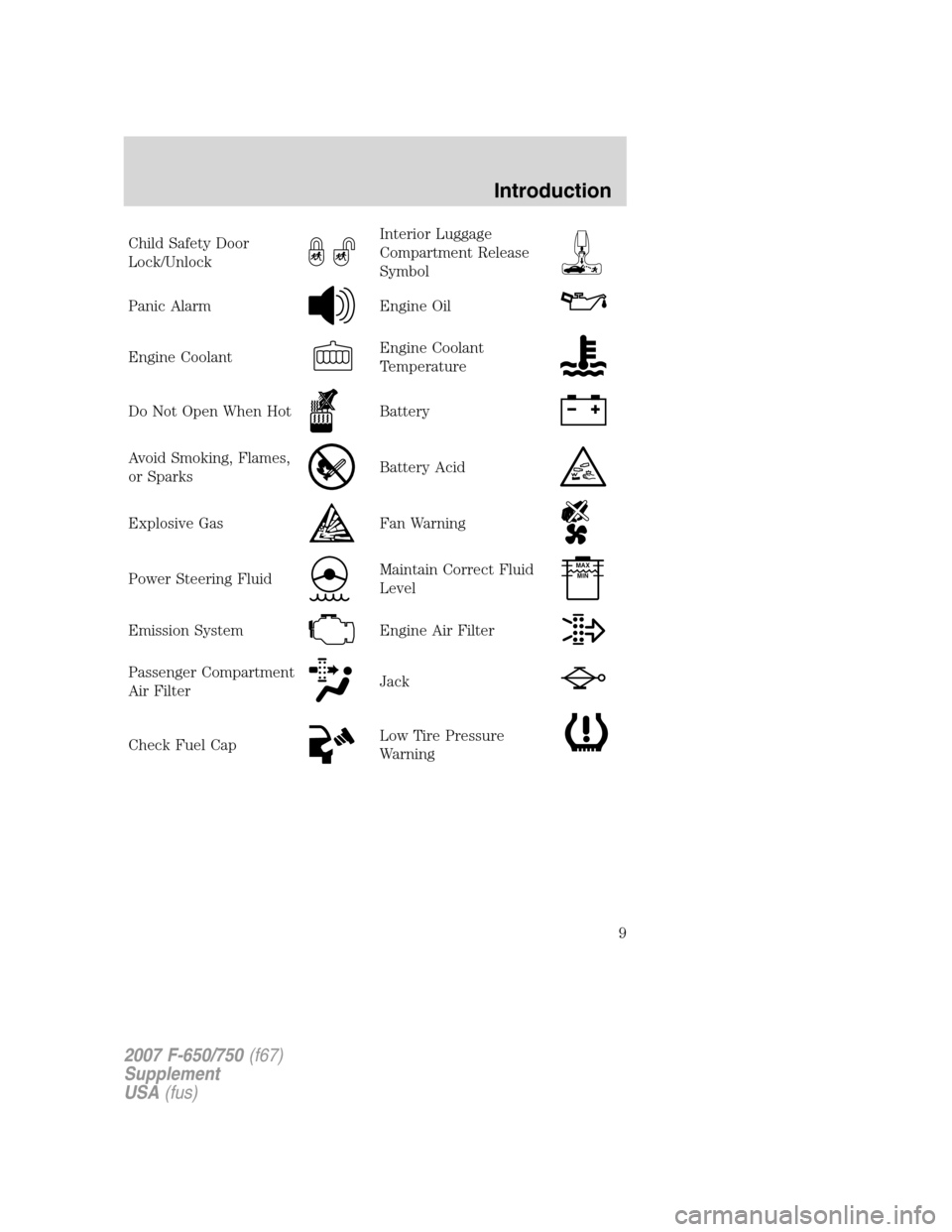
Child Safety Door
Lock/UnlockInterior Luggage
Compartment Release
Symbol
Panic AlarmEngine Oil
Engine CoolantEngine Coolant
Temperature
Do Not Open When HotBattery
Avoid Smoking, Flames,
or SparksBattery Acid
Explosive GasFan Warning
Power Steering FluidMaintain Correct Fluid
LevelMAX
MIN
Emission SystemEngine Air Filter
Passenger Compartment
Air FilterJack
Check Fuel CapLow Tire Pressure
Warning
2007 F-650/750(f67)
Supplement
USA(fus)
Introduction
9
Page 29 of 280
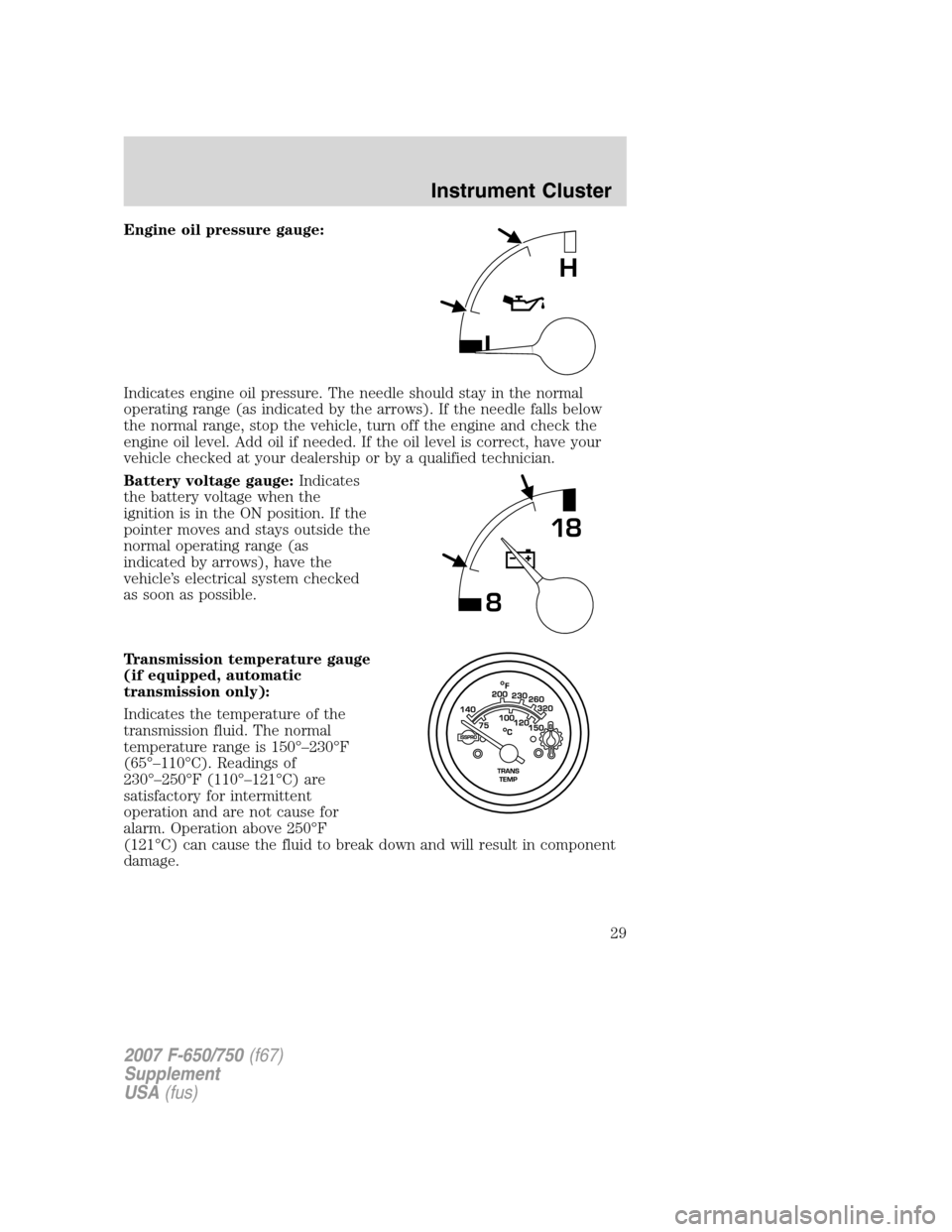
Engine oil pressure gauge:
Indicates engine oil pressure. The needle should stay in the normal
operating range (as indicated by the arrows). If the needle falls below
the normal range, stop the vehicle, turn off the engine and check the
engine oil level. Add oil if needed. If the oil level is correct, have your
vehicle checked at your dealership or by a qualified technician.
Battery voltage gauge:Indicates
the battery voltage when the
ignition is in the ON position. If the
pointer moves and stays outside the
normal operating range (as
indicated by arrows), have the
vehicle’s electrical system checked
as soon as possible.
Transmission temperature gauge
(if equipped, automatic
transmission only):
Indicates the temperature of the
transmission fluid. The normal
temperature range is 150°–230°F
(65°–110°C). Readings of
230°–250°F (110°–121°C) are
satisfactory for intermittent
operation and are not cause for
alarm. Operation above 250°F
(121°C) can cause the fluid to break down and will result in component
damage.
L
H
818
2007 F-650/750(f67)
Supplement
USA(fus)
Instrument Cluster
29
Page 93 of 280
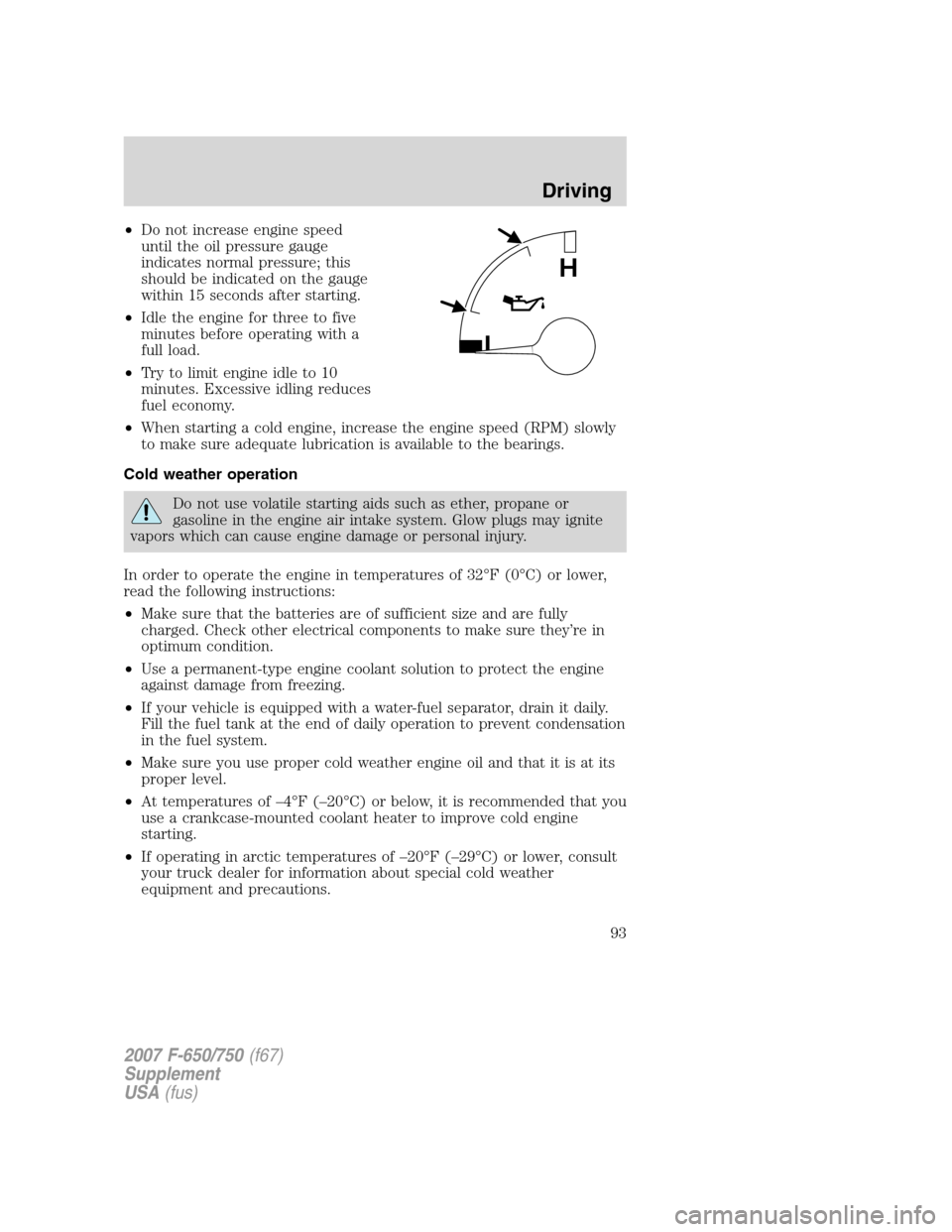
•Do not increase engine speed
until the oil pressure gauge
indicates normal pressure; this
should be indicated on the gauge
within 15 seconds after starting.
•Idle the engine for three to five
minutes before operating with a
full load.
•Try to limit engine idle to 10
minutes. Excessive idling reduces
fuel economy.
•When starting a cold engine, increase the engine speed (RPM) slowly
to make sure adequate lubrication is available to the bearings.
Cold weather operation
Do not use volatile starting aids such as ether, propane or
gasoline in the engine air intake system. Glow plugs may ignite
vapors which can cause engine damage or personal injury.
In order to operate the engine in temperatures of 32°F (0°C) or lower,
read the following instructions:
•Make sure that the batteries are of sufficient size and are fully
charged. Check other electrical components to make sure they’re in
optimum condition.
•Use a permanent-type engine coolant solution to protect the engine
against damage from freezing.
•If your vehicle is equipped with a water-fuel separator, drain it daily.
Fill the fuel tank at the end of daily operation to prevent condensation
in the fuel system.
•Make sure you use proper cold weather engine oil and that it is at its
proper level.
•At temperatures of –4°F (–20°C) or below, it is recommended that you
use a crankcase-mounted coolant heater to improve cold engine
starting.
•If operating in arctic temperatures of –20°F (–29°C) or lower, consult
your truck dealer for information about special cold weather
equipment and precautions.
L
H
2007 F-650/750(f67)
Supplement
USA(fus)
Driving
93
Page 97 of 280

ENGINE AUTOMATIC SHUTDOWN WARNING LIGHT OR CHIME (IF
EQUIPPED)
Your vehicle may be equipped with an automatic shutdown feature that
stops the engine in the event of high coolant temperature, low engine oil
pressure or low engine coolant level. A warning light in the instrument
cluster and a warning chime will indicate high engine coolant
temperature or low engine oil pressure. If the temperature and/or
pressure becomes too high or too low, the engine will automatically shut
down.
Vehicles that are equipped with an
override feature, allow the operator
to restart the engine so the vehicle
can be moved; the engine should
not be operated any longer than
necessary. A decal located in front
of the operator provides instructions
on how the override should be
operated.
Do not attempt to use this restarting feature to drive the vehicle very far
as serious engine damage could result.
In the event of engine shutdown, make sure the vehicle is safely
off the road and the problem is remedied prior to returning to
the road. Failure to remove the vehicle from the road could result in
an accident, causing serious injury or death.
SHDN
OVRD
2007 F-650/750(f67)
Supplement
USA(fus)
Driving
97
Page 176 of 280

Do not put engine coolant in the washer fluid reservoir. Engine
coolant can severely reduce visibility if sprayed on the
windshield.
CHANGING THE WIPER BLADES
To replace the wiper blades:
1. Pull the wiper arm away from the
windshield and lock into the service
position.
2. Turn the blade at an angle from
the wiper arm. Push the lock pin
manually to release the blade and
pull the wiper blade down toward
the windshield to remove it from the
arm.
3. Attach the new wiper to the
wiper arm and press it into place
until a click is heard.
ENGINE OIL
Checking the engine oil
Refer to the Scheduled Maintenance Guide chapter for the appropriate
intervals for checking the engine oil. Check the engine oil level
consistently and accurately.
If your vehicle is equipped with a Cummins or Caterpillar engine,
refer to the appropriate engine operator’s manual for information on the
engine oil.
If your vehicle is equipped with the 6.0L Power Stroke engine,
perform the following procedure:
1. Start the engine and let it run until it reaches normal operating
temperature (the engine coolant temperature gauge indicator will be
near the center of the normal area between H and C).
2. Park the vehicle on level ground.
3. Set the parking brake and shift into N (Neutral) (automatic
transmission) or 1 (First) (manual transmission).
2007 F-650/750 (f67)
Supplement
USA (fus)
Maintenance and Specifications
176
Page 177 of 280
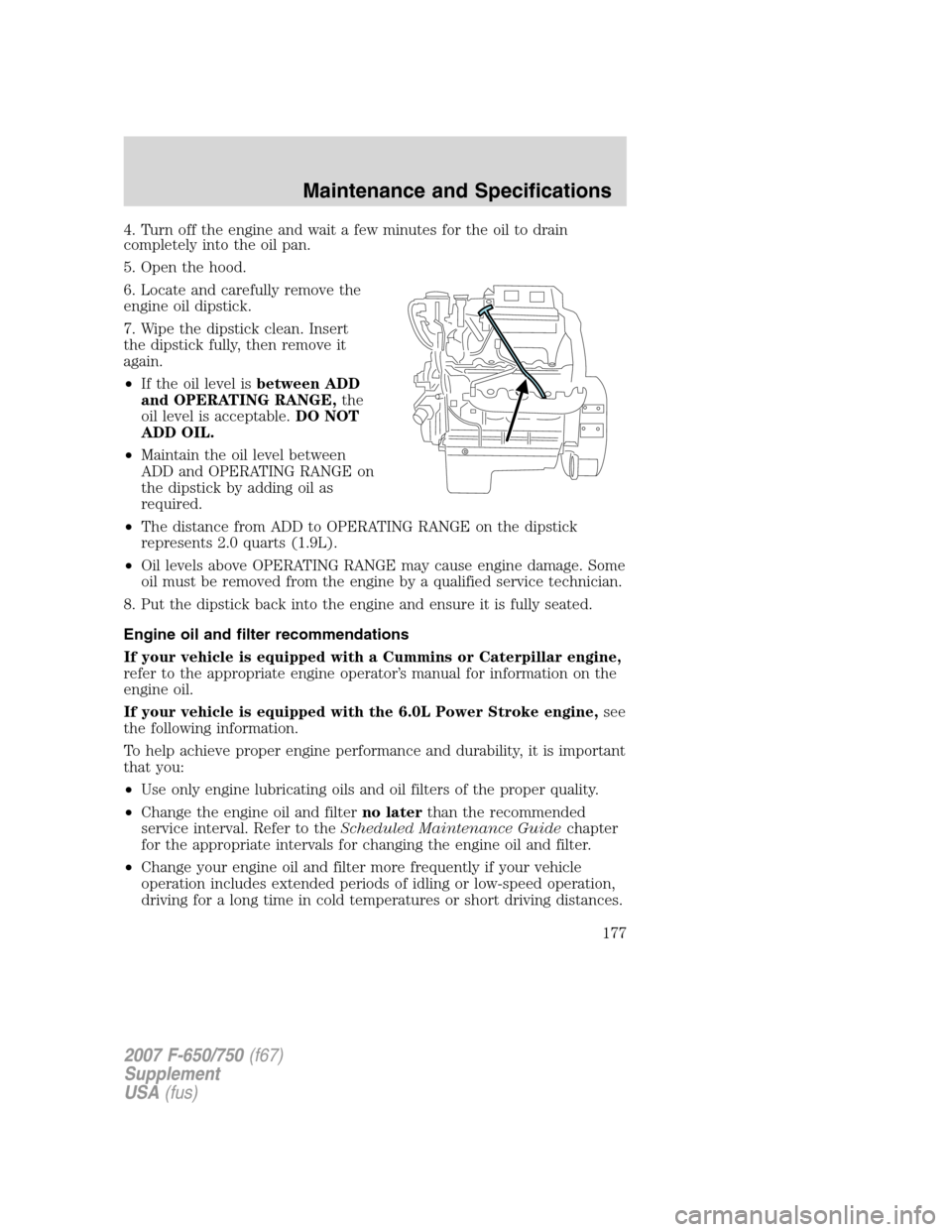
4. Turn off the engine and wait a few minutes for the oil to drain
completely into the oil pan.
5. Open the hood.
6. Locate and carefully remove the
engine oil dipstick.
7. Wipe the dipstick clean. Insert
the dipstick fully, then remove it
again.
•If the oil level is between ADD
and OPERATING RANGE, the
oil level is acceptable. DO NOT
ADD OIL.
• Maintain the oil level between
ADD and OPERATING RANGE on
the dipstick by adding oil as
required.
• The distance from ADD to OPERATING RANGE on the dipstick
represents 2.0 quarts (1.9L).
• Oil levels above OPERATING RANGE may cause engine damage. Some
oil must be removed from the engine by a qualified service technician.
8. Put the dipstick back into the engine and ensure it is fully seated.
Engine oil and filter recommendations
If your vehicle is equipped with a Cummins or Caterpillar engine,
refer to the appropriate engine operator’s manual for information on the
engine oil.
If your vehicle is equipped with the 6.0L Power Stroke engine, see
the following information.
To help achieve proper engine performance and durability, it is important
that you:
• Use only engine lubricating oils and oil filters of the proper quality.
• Change the engine oil and filter no laterthan the recommended
service interval. Refer to the Scheduled Maintenance Guide chapter
for the appropriate intervals for changing the engine oil and filter.
• Change your engine oil and filter more frequently if your vehicle
operation includes extended periods of idling or low-speed operation,
driving for a long time in cold temperatures or short driving distances.
2007 F-650/750 (f67)
Supplement
USA (fus)
Maintenance and Specifications
177
Page 178 of 280
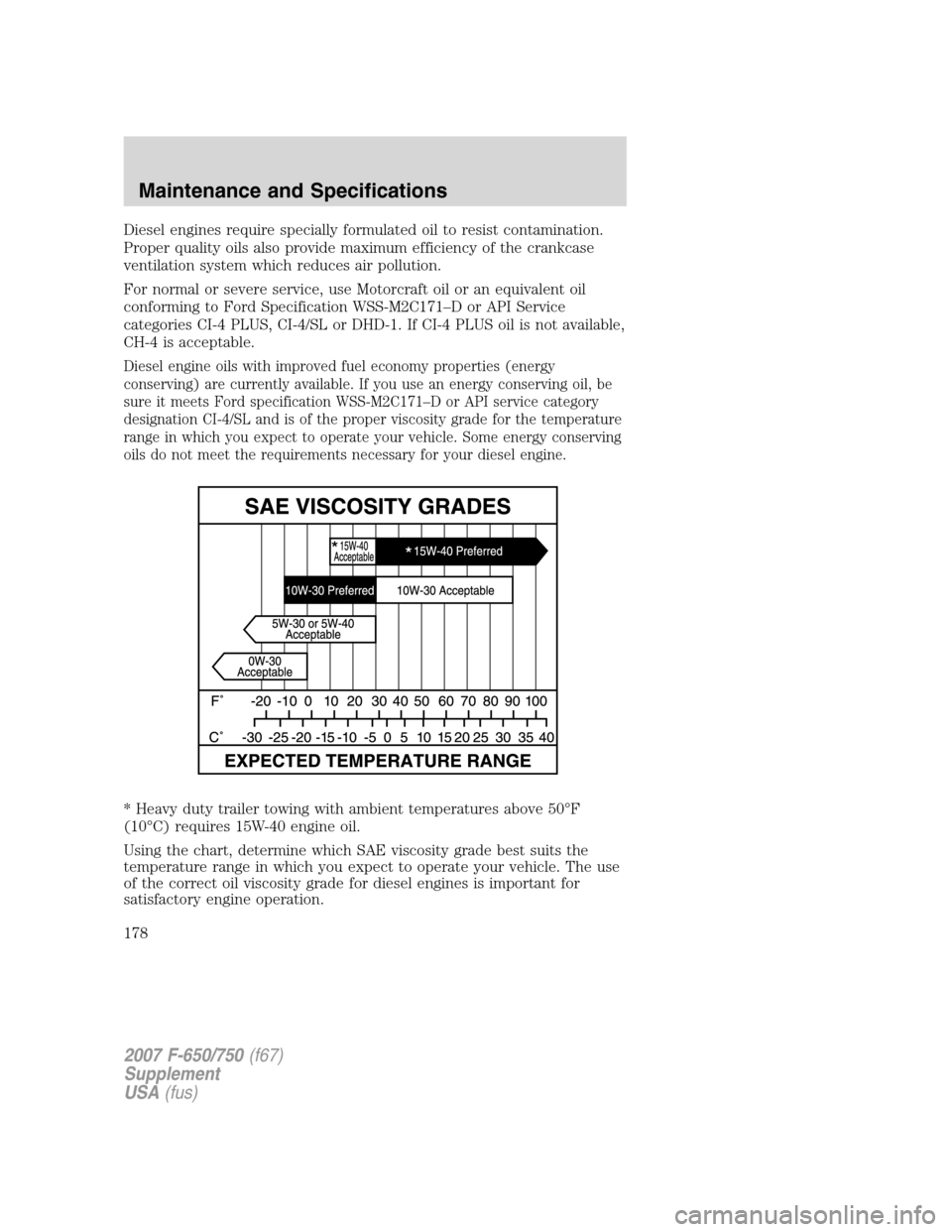
Diesel engines require specially formulated oil to resist contamination.
Proper quality oils also provide maximum efficiency of the crankcase
ventilation system which reduces air pollution.
For normal or severe service, use Motorcraft oil or an equivalent oil
conforming to Ford Specification WSS-M2C171–D or API Service
categories CI-4 PLUS, CI-4/SL or DHD-1. If CI-4 PLUS oil is not available,
CH-4 is acceptable.
Diesel engine oils with improved fuel economy properties (energy
conserving) are currently available. If you use an energy conserving oil, be
sure it meets Ford specification WSS-M2C171–D or API service category
designation CI-4/SL and is of the proper viscosity grade for the temperature
range in which you expect to operate your vehicle. Some energy conserving
oils do not meet the requirements necessary for your diesel engine.
* Heavy duty trailer towing with ambient temperatures above 50°F
(10°C) requires 15W-40 engine oil.
Using the chart, determine which SAE viscosity grade best suits the
temperature range in which you expect to operate your vehicle. The use
of the correct oil viscosity grade for diesel engines is important for
satisfactory engine operation.
2007 F-650/750(f67)
Supplement
USA (fus)
Maintenance and Specifications
178
Page 190 of 280

If you do not use the proper fuel filler cap, excessive pressure or
vacuum in the fuel tank may damage the fuel system or cause
the fuel cap to disengage in a collision, which may result in possible
personal injury.
Choosing the right fuel
The engine is designed to use low sulfur number 1D or 2D diesel fuel
only. At temperatures below –20°F (–7°C), number 1D or winter blend
number 2D fuel is recommended. (SeeCold weather operationin the
Drivingsection.) Diesel fuel containing no more than 5% of biodiesel
may be used. Biodiesel fuel is a product derived from renewable fuel
sources such as vegetable oil, animal fat and cooking oil.
Do not use home heating oil or any diesel fuel not intended for
highway use. Red dye is used to identify fuels intended for
agricultural and non-highway use. Damage to the fuel injection
system, engine and exhaust catalyst can occur if an improper fuel
is used. Do not add gasoline, gasohol or alcohol to diesel fuel.
This practice creates a serious fire hazard and engine
performance problems.
Use low sulfur (less than 0.05% by weight) fuel as required by the EPA
for emission compliance.
Do not mix diesel fuel with gasoline, gasohol or alcohol. This
could cause an explosion resulting in personal injury.
Do not use starting fluid such as ether or gasoline. Such fluids
can cause immediate explosive damage to the engine and
possible personal injury.
Fuel quality
It should not be necessary to add any aftermarket additives to your fuel
tank if you use a properly formulated diesel fuel that meets ASTM D 975
specification. Aftermarket additives can damage the injector system or
engine. Repairs to correct the effects of using an aftermarket product in
your fuel may not be covered by your warranty.
Do not blend used engine oil with diesel fuel under any
circumstances.Blending used oil with the fuel will significantly increase
your vehicle’s exhaust emissions and reduce engine life due to increased
internal wear.
2007 F-650/750(f67)
Supplement
USA(fus)
Maintenance and Specifications
190
Page 194 of 280

•Fuel economy may decrease with lower temperatures during the first
8–10 miles (12–16 km) of driving.
•Flat terrain driving improves fuel economy over hilly roads.
•Transmissions give their best fuel economy when operated in the top
cruise gear and with steady pressure on the accelerator.
•Close windows for highway driving.
NOISE EMISSIONS – EXTERIOR
In order to comply with the federal exterior noise regulations, your
vehicle may be equipped with noise emission items. Depending on the
vehicle configuration, it may have all or some of the following items:
Air Intake System
•Air Cleaner:should be inspected and its location should not be
altered. Do not alter inlet and outlet piping.
Body
•Wheel Well:splash shields, cab shields and under-hood insulation
should be inspected for deterioration, dislocation, and orientation.
Cooling System
•Check the fan for damage to blades; replace, if damaged, with the
recommended parts. Inspect for fan to shroud interference, and any
damage to shroud such as cracks and holes.
•The fan ratio should not be changed and the fan spacer dimensions
and positions should not be altered.
•Inspect the fan clutch for proper operation, make sure that the fan is
disengaged when cooling of the engine is not required.
•Check for proper operation of radiator shutters, if equipped. The
shutters should be open during normal operating temperatures.
Engine and Driveline System
•Transmission Enclosure:inspect for cracks, holes, and tears. Clean
any deposits such as oil, dirt, and stones.
•Engine valve covers and block covers are made to damp out engine
mechanical noise and, if needed, should be replaced with
recommended parts. Check for mechanical isolations.
Exhaust System
•Inspect the exhaust system for leaks at various joint connections and
tighten the clamps.
2007 F-650/750(f67)
Supplement
USA(fus)
Maintenance and Specifications
194
Page 214 of 280
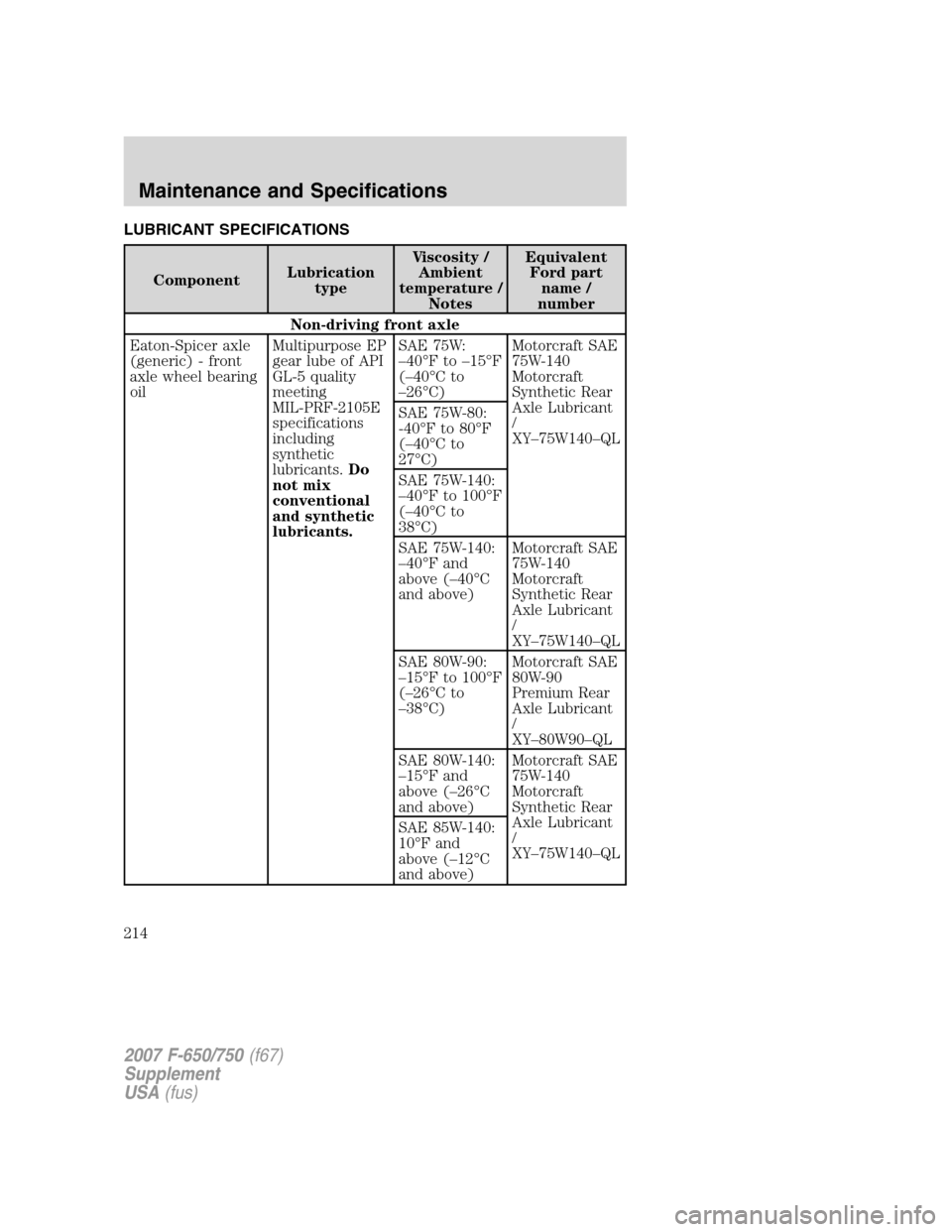
LUBRICANT SPECIFICATIONS
ComponentLubrication
typeViscosity /
Ambient
temperature /
NotesEquivalent
Ford part
name /
number
Non-driving front axle
Eaton-Spicer axle
(generic) - front
axle wheel bearing
oilMultipurpose EP
gear lube of API
GL-5 quality
meeting
MIL-PRF-2105E
specifications
including
synthetic
lubricants.Do
not mix
conventional
and synthetic
lubricants.SAE 75W:
–40°F to –15°F
(–40°C to
–26°C)Motorcraft SAE
75W-140
Motorcraft
Synthetic Rear
Axle Lubricant
/
XY–75W140–QL SAE 75W-80:
-40°F to 80°F
(–40°C to
27°C)
SAE 75W-140:
–40°F to 100°F
(–40°C to
38°C)
SAE 75W-140:
–40°F and
above (–40°C
and above)Motorcraft SAE
75W-140
Motorcraft
Synthetic Rear
Axle Lubricant
/
XY–75W140–QL
SAE 80W-90:
–15°F to 100°F
(–26°C to
–38°C)Motorcraft SAE
80W-90
Premium Rear
Axle Lubricant
/
XY–80W90–QL
SAE 80W-140:
–15°F and
above (–26°C
and above)Motorcraft SAE
75W-140
Motorcraft
Synthetic Rear
Axle Lubricant
/
XY–75W140–QL SAE 85W-140:
10°F and
above (–12°C
and above)
2007 F-650/750(f67)
Supplement
USA(fus)
Maintenance and Specifications
214